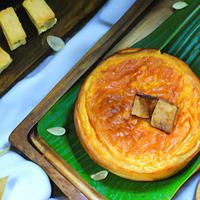
1 serving (150 grams) contains 300 calories, 5.0 grams of protein, 10.0 grams of fat, and 50.0 grams of carbohydrates.

Log this food in SnapCalorie

Nutrition Information
Calories |
480 | ||
|---|---|---|---|
% Daily Value* |
|||
| Total Fat | 16.0 g | 20% | |
| Saturated Fat | 8.0 g | 40% | |
| Polyunsaturated Fat | 0 g | ||
| Cholesterol | 48 mg | 16% | |
| Sodium | 320.0 mg | 13% | |
| Total Carbohydrates | 80.0 g | 29% | |
| Dietary Fiber | 3.2 g | 11% | |
| Sugars | 32.0 g | ||
| protein | 8.0 g | 16% | |
| Vitamin D | 0 mcg | 0% | |
| Calcium | 160.0 mg | 12% | |
| Iron | 2.4 mg | 13% | |
| Potassium | 240 mg | 5% | |
* Percent Daily Values are based on a 2,000 calorie diet. Your daily values may be higher or lower depending on your calorie needs.
Food Attributes
Source of Calories
About Bibingka
Bibingka is a traditional Filipino baked rice cake made primarily from rice flour, coconut milk, sugar, and eggs. Often topped with salted egg and shredded cheese, it’s cooked in a clay pot lined with banana leaves, giving it a distinct aroma and flavor. Bibingka is commonly enjoyed during Christmas season celebrations in the Philippines, served warm alongside festive beverages. Nutritionally, it provides carbohydrates as a key energy source, thanks to its base of rice flour and sugar. The addition of eggs contributes some protein, while coconut milk offers medium-chain triglycerides, a type of fat believed to support energy metabolism. However, Bibingka can be high in refined carbohydrates and sugar, which may lead to spikes in blood sugar levels. Salted egg and cheese toppings also increase sodium content, making mindful portions important for balanced consumption. It’s a delightful treat best enjoyed in moderation as part of a festive diet.



